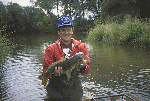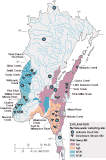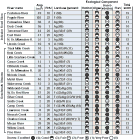Water Quality in the Western Lake Michigan Drainages, Wisconsin and Michigan, 1992-95
Table of contents || Previous section || Next section || Glossary
Stream ecology can be affected by a wide variety of human and natural factors. Sampling stream habitat and communities of fish, benthic invertebrates, and algae provides a unique assessment of the overall health of streams. Relating these findings to information about the natural and human features found in the sampled basins can provide important information for management of land and water resources.
Nearly 500 biological studies conducted in the study area between 1891 and 1996 were identified that relate to water-quality conditions. Most of these studies focused on populations and community structure of aquatic biota in streams thought to be degraded as a result of human activity (Scudder and others, 1996).
 (14,852 bytes)
(14,852 bytes)
The number of each type of fish species present in streams provides an indication of stream-water quality. Twenty-one of the 28 streams sampled were classified as coldwater trout streams (Sullivan, 1997; Sullivan and Peterson, 1997).
 (34,342 bytes)
(34,342 bytes)
Twenty benchmark streams in a predominantly agricultural part of the study area were selected for detailed ecological studies (Rheaume, Stewart, and Lenz, 1996). These studies were also done at the eight Indicator Fixed Sites (Sullivan and others, 1995). The ecological studies conducted at the 28 sites were designed to study the effects of environmental setting on aquatic life. The studies conducted at the 20 benchmark stream sites were also designed to define aquatic life conditions in less-degraded watersheds located in primarily agricultural areas.
Indexes of biotic integrity were calculated for each of the four ecological components for 28 streams in the study area. These biotic indexes were developed to provide an indication of water quality based on the ecological component sampled. Results of the calculated indexes for the Indicator and benchmark sites were compared to land use, surficial deposit, and bedrock information in each basin to determine the influence of these environmental factors on aquatic life in the basin.
In general, there was good agreement between individual ecological component scores. At only one of the 20 benchmark streams did results vary by more than one quality category. At four of the eight Indicator Fixed Sites scores varied by two quality categories.
Overall water quality at the benchmark streams, as indicated by the four ecological component scores, varied little within each of the four RHUs sampled. Biotic indexes indicated that water quality at the benchmark streams in RHU 26 were of slightly higher quality than benchmark streams in RHU 3. Benchmark streams in RHU 26 had nearly twice as much forested land in their basins than did RHU 3 streams.
 (39,792 bytes)
(39,792 bytes)
Biological indexes for habitat (Great Lakes Environmental Assessment, GLEAS; Michigan Department of Natural Resources, 1991), algae (Index of Biological Integrity, IBI; Bahls, 1993), benthic invertebrates (Hilsenhoff Biotic Indexes, HBI and FBI; Hilsenhoff, 1987), and fish (Index of Biological Integrity, IBI; Lyons, 1992 and Lyons and others, 1996) indicate the water quality of streams in the study area. Total score determined by assigning point values for each quality score as shown in parentheses. Abbreviations: Ag, agriculture; F, forest; W, wetland
 (64,988 bytes)
(64,988 bytes)
Caddisfly larvae are generally found where habitat and water quality conditions are good. Additional discussion of habitat conditions and invertebrate communities in the study area can be found in Fitzpatrick and Giddings, 1997; Fitzpatrick, Peterson and Stewart, 1996; and Rheaume, Lenz, and Scudder, 1996.
Water quality, as indicated by biotic indexes, varied considerably between Indicator Fixed Sites. The urban site had the worst water quality and the forested sites the best water quality. At the agricultural Indicator Fixed Sites, water quality varied considerably. Scores were nearly as low as the urban site where percent agriculture in the basin was highest; and scores were as high as the forested sites where agricultural land use percentage was lowest.
Lowest overall scores were from basins with clay surficial deposits. There was no apparent correlation between biotic indexes and bedrock type or drainage basin area.
U.S. Geological Survey Circular 1156
Table of contents || Previous section || Next section || Glossary
Suggested citation:
C. A. Peters, D. M. Robertson, D. A. Saad, D. J. Sullivan, B. C. Scudder, F. A. Fitzpatrick, K. D. Richards, J. S. Stewart, S. A. Fitzgerald, and B. N. Lenz, 1998, U.S. Geological Survey Circular 1156, on line at <URL: https://water.usgs.gov/pubs/circ1156>, updated June 11, 1998